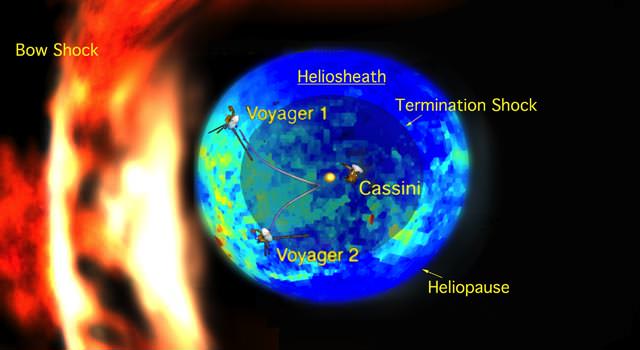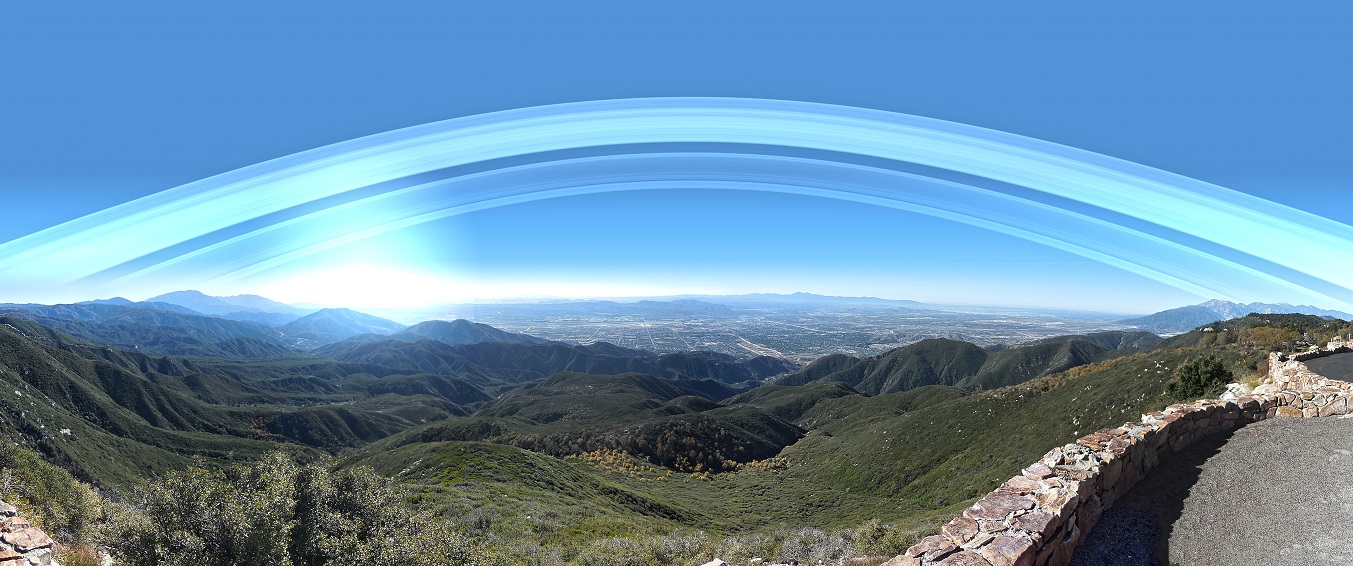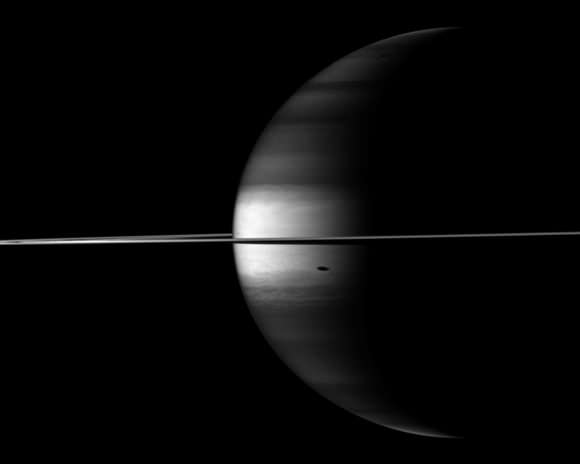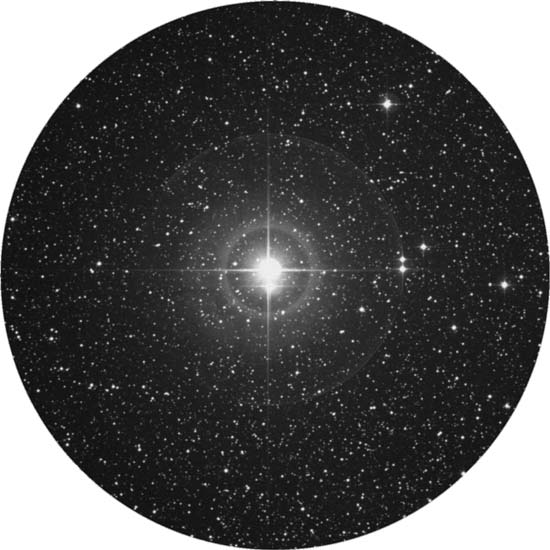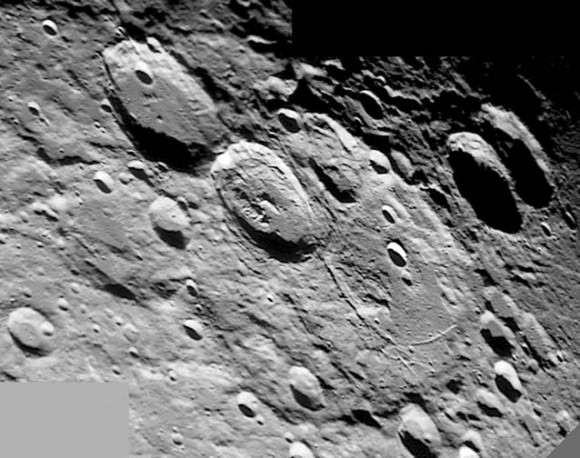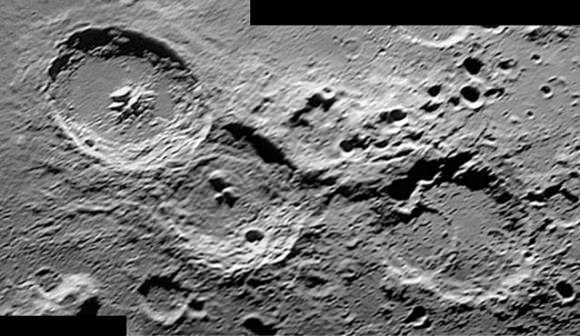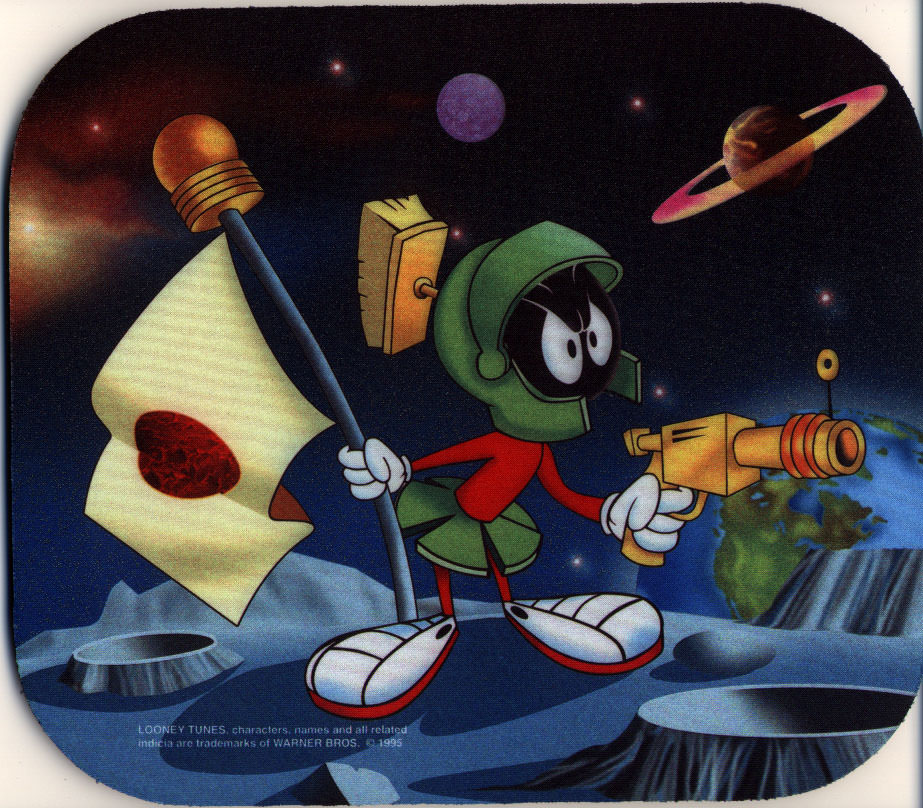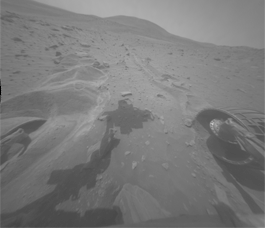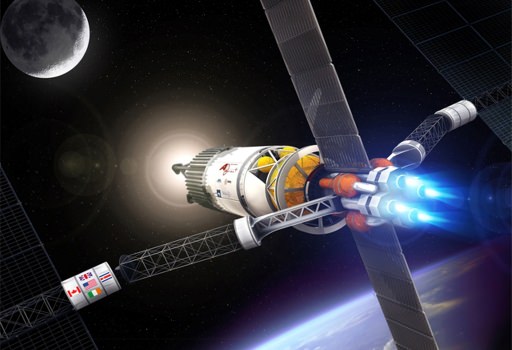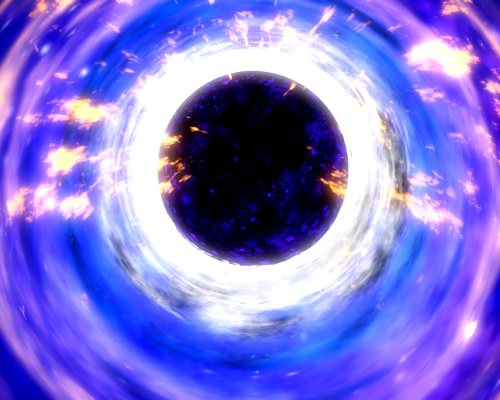Early Nov. 18th, eyewitnesses reported an explosion in the atmosphere above Colorado, Utah, Wyoming and Idaho in the western United States. Some said the fireball “turned night into day” and produced shock waves that shook the ground when it exploded just after midnight Mountain Standard Time. Infrasound recordings of the blast suggest a small asteroid hitting Earth’s atmosphere and exploding with an energy of 0.5 to 1 kiloton of TNT. As the sun rose in the morning, remnants of the explosion were visible as noctilucent clouds over the region. The best video of the extremely bright event was just recently released, from the University of Utah’s Eccles Observatory.
Continue reading “Video of Utah Fireball”
Cassini/IBEX Data Changes View of Heliosphere Shape
Though the Cassini mission has focused intently on scientific exploration of Saturn and its moons, data taken by the spacecraft has significantly changed the way astronomers think about the shape of our Solar System. As the Sun and planets travel through space, the bubble in which they reside has been thought to resemble a comet, with a long tail and blunt nose. Recent data from Cassini combined with that of other instruments, shows that the local intertstellar magnetic field shapes the heliosphere differently.
The Solar System resides in a bubble in the interstellar medium – called the “heliosphere” – which is created by the solar wind. The shape carved out of the interstellar dust by the solar wind has been thought for the past 50 years to resemble a comet, with a long tail and blunted nose shape, caused by the motion of the Solar System through the dust.
Data taken by Cassini’s Magnetospheric Imaging Instrument (MIMI) and the Interstellar Boundary Explorer (IBEX) shows that there is more to the forces that cause the shape than previously thought, and that the shape of the heliosphere more closely resembles a bubble.
The shape of the heliosphere was previously thought to have been carved out solely by the interaction of the solar wind particles with the interstellar medium, the resulting “drag” creating a wispy tail. The new data suggests, however, that the interstellar magnetic field slips around the heliosphere and the outer shell, called the heliosheath, leaving the spherical shape of the heliosphere intact. Below is an image representing what the heliosphere was thought to look like before the new data.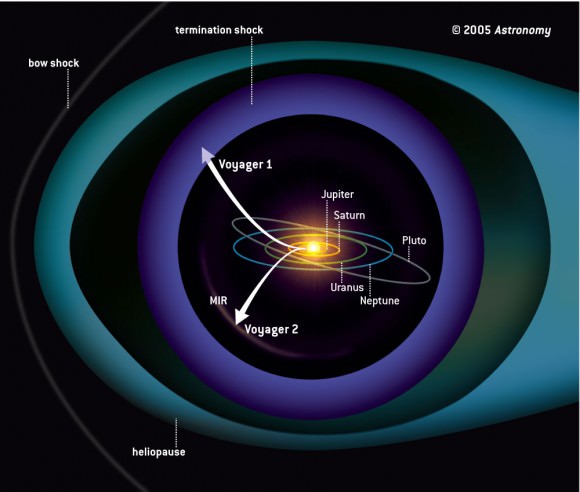
The new data also provide a much clearer indication of how thick the heliosheath is, between 40 and 50 astronomical units. This means that NASA’s Voyager spacecraft, Voyager 1 and Voyager 2, which are both traveling through the heliosheath now, will cross into interstellar space before the year 2020. Previous estimates had put that date as far back as 2030.
MIMI was originally designed to take measurements of Saturn’s magnetosphere and surrounding energetic charged particle environment. Since Cassini is far away from the Sun, though, it also places the spacecraft in a unique position to measure the energetic neutral atoms coming from the boundaries of the heliosphere. Energetic neutral atoms form when cold, neutral gas comes into contact with electrically-charged particles in a plasma cloud. The positively-charged ions in plasma can’t reclaim their own electrons, so they steal those of the cold gas atoms. The resulting particles are then neutrally charged, and able to escape the pull of magnetic fields and travel into space.
Energetic neutral atoms form in the magnetic fields around planets, but are also emitted by the interaction between the solar wind and the interstellar medium. Tom Krimigis, principal investigator of the Magnetospheric Imaging Instrument (MIMI) at Johns Hopkins University’s Applied Physics Laboratory in Laurel, Md and his team weren’t sure if the instruments on Cassini would originally be able to detect sources of energetic neutral atoms from as far out as the heliosphere, but after their four-year study of Saturn, they looked into the data from the instrument to see if any particles had strayed in from sources outside the gas planet. To their surprise, there was enough data to complete a map of the intensity of the atoms, and discovered a belt of hot, high pressure particles where the interstellar wind flows by our heliosheath bubble.
The data from Cassini complements that taken by IBEX and the two Voyager spacecraft. The combined information from IBEX, Cassini and the Voyager missions enabled scientists to complete the picture of our little corner of space. To see a short animation of the heliosphere as mapped by Cassini, go here. The results of the combined imaging were published in Science on November 13th, 2009.
Source: JPL
What If Earth Had Rings?
Here’s a video that poses — and answers — an interesting question: what would Earth look like if it had rings like Saturn? This animation was done by artist Roy Prol, and it shows not only how the rings would look from space, but also the view Earthlings would have of the rings.
Prol says the ring views from Earth’s surface were created according to the location’s latitude and the viewer’s orientation, and that the size of the rings was calculated respecting the Roche limit for the Earth. As you can se in the video, the rings would look different, depending on where you were on our planet. A very intriguing concept, and the video is very well done.
The only bad thing about Earth having rings is that we probably wouldn’t have our beautiful Moon. Imagine, instead of all the songs, poems and paintings of the Moon over the past centuries, we’d have odes to our rings.
One of our favorite image editing artists is Kevin Gill, and he’s also created imagery of Earth having rings, such as our lead image, which shows Earth’s Rings over San Bernadino, California and this one, below:
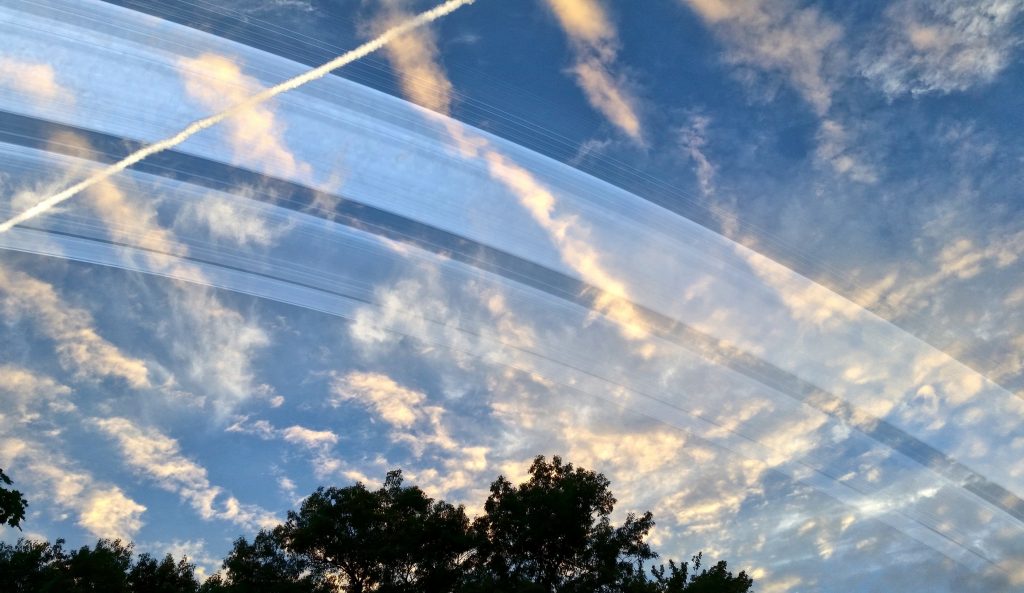
More Cassini Eye Candy: Infrared Saturn, Peek-a-boo Moons
The “wow” factor from the Cassini mission never quits. Here’s the latest image, released just today of Saturn, viewed in near-infrared. This image was taken with Cassini’s wide-angle camera on Oct. 23, 2009 using a spectral filter sensitive to wavelengths of near-infrared light, centered at 890 nanometers. The view was acquired at a distance of approximately 2.6 million kilometers (1.6 million miles) from Saturn. The large shadow south of the equator is from the moon Tethys (1062 kilometers, 660 miles across). The small shadow near the limb of the planet, north of the equator, is the shadow of the moon Mimas (396 kilometers, 246 miles across). Absolutely stunning.
See below for more Cassini goodness of moons playing peek-a-boo with the rings and each other.
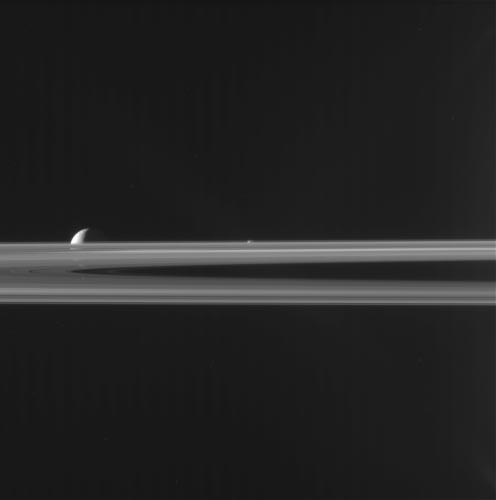
Here, Janus and another moon hide behind Saturn’s rings.
You don’t see this every day: a crescent Enceladus being eclipsed by a crescent Rhea. Gorgeous!
Click on the images to go directly to the Cassini image pages. See more gorgeous shots at CICLOPS
Weekend SkyWatcher’s Forecast – November 20 -22, 2009
Greetings, fellow SkyWatchers! Yep. The Moon is back, but this weekend can still present some great opportunities for enjoying astronomy. If you’re up early or out late? Well, hey… The Leonid meteor shower is still producing activity! Why not take a few minutes to learn about a great variable star you can follow without optical aid or study a new lunar feature? There’s plenty to do for binoculars and small telescopes – and perhaps even a clever new study you haven’t looked at yet! Whenever you’re ready, I’ll see you in the dark…
 Friday, November 20, 2009 – Today celebrates the birth of a significant astronomer, Edwin Hubble. Born on this date in 1889, Hubble became the first American astronomer to identify Cepheid variables in M31, which in turn established the extragalactic nature of the spiral nebulae. Continuing with the work of Carl Wirtz, and using Vesto Slipher’s redshifts, Hubble could then calculate the velocity–distance relation for galaxies. This has become known as Hubble’s Law and demonstrates the expansion of our universe.
Friday, November 20, 2009 – Today celebrates the birth of a significant astronomer, Edwin Hubble. Born on this date in 1889, Hubble became the first American astronomer to identify Cepheid variables in M31, which in turn established the extragalactic nature of the spiral nebulae. Continuing with the work of Carl Wirtz, and using Vesto Slipher’s redshifts, Hubble could then calculate the velocity–distance relation for galaxies. This has become known as Hubble’s Law and demonstrates the expansion of our universe.
Tonight we’ll pass the Moon and head just a little more than a fist-width west of the westernmost bright star in Cassiopeia, to have a look at Delta Cephei (RA 22 29 10 Dec +58 24 54). This is the most famous of all variable stars and the granddaddy of all Cepheids. Discovered in 1784 by John Goodricke, its changes in magnitude are not due to a revolving companion but rather the pulsations of the star itself.
Ranging over almost a full magnitude in 5 days, 8 hours, and 48 minutes precisely, Delta’s changes can easily be followed by comparing it to nearby Zeta and Epsilon. Upon reaching its dimmest point, it will brighten rapidly in a period of about 36 hours yet take 4 days to slowly dim again. Take time out of your busy night to watch Delta change and change again. It’s only 1,000 light-years away and doesn’t even require a telescope! (But even binoculars will show its optical companion.)
Saturday, November 21, 2009 – Tonight let’s go to the southern lunar cusp to identify two small but very nice craters. Using previous study Fabricus, continue south and look for the pair connected side-to-side rather than end-to-end.
This is crater Watt, with Steinheil intruding on it. Remember the distance traveled south from Fabricus to this pair and extend that distance even further south. Seen on the limb is crater Biela. If conditions are stable, you might pick up a tiny black point in Beila’s west wall, Biela C.
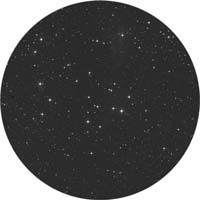 Before we retire to the shadows tonight, let’s study the small, open cluster NGC 225, located a finger-width northwest of Gamma Cassiopeiae (RA 00 43 42 Dec +61 47 00). This 7th magnitude collection has been described by some as looking like a sailboat. A fascinating name might be the ‘‘Metamorphosis Cluster,’’ since the southwestern region of the cluster looks like a butterfly asterism and, to the northeast is the caterpillar-like asterism. Although just barely detectable as an unresolved patch through binoculars on a dark night, tonight’s Moon means that magnification is needed just to make out its half-dozen brighter 9th magnitude members. Modest scopes should reveal two dozen stars to magnitude 12.
Before we retire to the shadows tonight, let’s study the small, open cluster NGC 225, located a finger-width northwest of Gamma Cassiopeiae (RA 00 43 42 Dec +61 47 00). This 7th magnitude collection has been described by some as looking like a sailboat. A fascinating name might be the ‘‘Metamorphosis Cluster,’’ since the southwestern region of the cluster looks like a butterfly asterism and, to the northeast is the caterpillar-like asterism. Although just barely detectable as an unresolved patch through binoculars on a dark night, tonight’s Moon means that magnification is needed just to make out its half-dozen brighter 9th magnitude members. Modest scopes should reveal two dozen stars to magnitude 12.
Sunday, November 22, 2009 – On the lunar surface tonight, the three rings of Theophilus, Cyrillus, and Catharina will emerge, but tonight let’s power up on Theophilus and see what we can find! The area just northeast of Theophilus—where Mare Tranquillitatis and Mare Nectaris join—is called Sinus Asperitatis.
Toward its center, you will see the remains of a once grand (nameless) crater holding the younger, sharper Torricelli in its center. Dropping back to Theophilus, just outside of its east wall, you will also find a young crater, Madler. As you head east across the northern shore of Mare Nectaris, look carefully for two partial rings. The northernmost is so eroded that it never received a name, while a slight, faint horseshoe marks all that remains of Daguerre.
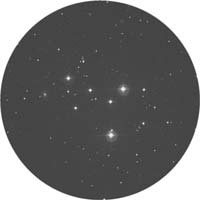 Tonight let’s test our starhopping and observing talents by starting first with a beautiful double – Gamma Arietis. Now look about a fist-width east-southeast for dim little Pi. When you have Pi centered, move about half a degree southwest for an alternative catalog study—DoDz 1.
Tonight let’s test our starhopping and observing talents by starting first with a beautiful double – Gamma Arietis. Now look about a fist-width east-southeast for dim little Pi. When you have Pi centered, move about half a degree southwest for an alternative catalog study—DoDz 1.
Although you might find this sparkling double handful of stars of little interest, think twice before you hop on. Although DoDz studies are far more scattered and less populous than most galactic clusters, it doesn’t make them less interesting. What you are looking at are basically the fossils of once active and more concentrated regions of stars. As the cluster has matured, the lower mass members have been stripped away and joined the general population. Known as a ‘‘dissolving cluster,’’ DoDz 1 is all that’s left of a far grander collection. Very ancient. . .yet still very beautiful!
Enjoy your celestial adventures!
This week’s awesome images are (in order of appearance): Edwin Hubble (widely used public image), Delta Cephei (credit—Palomar Observatory, courtesy of Caltech), Steinheil and Watt at limb (credit—Alan Chu), NGC 225 (credit—Palomar Observatory, courtesy of Caltech), Theophilus, Cyrillus, and Catharina (credit—Alan Chu) and Dolidze-Dzimselejsvili 1 (credit—Palomar Observatory, courtesy of Caltech). We thank you so much!
Want to be a Martian?
If you’ve ever dreamed of exploring Mars, but are worried about all that pesky radiation exposure and being cramped in a capsule for the two-year flight – or about never coming back – then your dream may be realized with NASA’s “Be a Martian” web site. In the spirit of other citizen scientist collaborations such as Galazy Zoo and Stardust@Home, NASA has created a site that allows you to view and categorize images to help map the Martian surface from the safety of your own home here on Earth.
The Be a Martian site is a collaboration between NASA and Microsoft that uses the tool of crowsourcing to sift through the hundreds of thousands of photos sent back by Mars rovers and orbiters. The format of the site is much like a game, where you complete tasks to earn points and badges.
There are two types of classifying activities to do on the site: count craters and match up images. Counting craters is just like it sounds: you are presented with an image, and place markers on any craters that you see. Counting craters in small regions on the Martian surface will help scientist determine the relative age of these regions – the more craters, the older an area is likely to be.
The image mapping is a bit trickier, though, because you have to match up 2-3 small, but high resolution images onto the background of a larger, much lower resolution image. The user starts in Vallis Marinaris, but can move onto other parts of Mars from there. By helping map the surface, better maps of the surface can be made to help scientists interpret the changing conditions of Mars.
Being a Martian citizen also has some civic responsibilities, too. There is a forum on the site where one can ask questions, vote on questions and make comments to earn “Curiousity Points”. NASA Mars experts will read the questions to see what the virtual Martian community is interested, and will host town hall-type meetings in the future where members can participate.
“We really need the next generation of explorers. And we’re also accomplishing something important for NASA. There’s so much data coming back from Mars. Having a wider crowd look at the data, classify it and help understand its meaning is very important,” Michelle Viotti, from the Jet Propulsion Laboratory told BBC News.
Extras are also available on the site, including wallpapers, mission overviews, and videos. You’ll need to have Microsoft’s Silverlight application for the games and videos on the site to work.
So, if you aren’t already completely addicted to Galaxy Zoo or any other citizen scientist site, now’s your chance! Oh, and if you want your Martian name to be Marvin, too bad – I tried, and it’s already been taken!
Source: Be a Martian, NASA
Spirit Rover Makes Progress
A little good news for Spirit! The rover successfully moved; not very much, but it’s the first step of a planned two-step motion to try and get Spirit free from a sand trap on Mars. On Sol 2090 (Nov. 19), the rover spun its wheels for the equivalent of 2.5 meters (8.2 feet) in the forward direction, and the center of the rover moved approximately 12 millimeters (0.5 inch) forward, 7 millimeters (0.3 inch) to the left and about 4 millimeters (0.2 inch) down. Again, not much, but it’s the first good news and good movement the rover has had in months.
Small forward motion was observed with the non-operable right front wheel, and the left front wheel showed indications of climbing, despite the center of the rover moving downward. These motions are too small to establish any trends at this time.
The drive plan had imposed a limit of 1 centimeter (0.4 inch) motion in any direction. The second step of the drive was not performed, because Spirit calculated it had exceeded that limit.
Source: JPL
The data downlink volume from the rover was much better than expected, with all drive-related imagery being received. The team is continuing to analyze results from the drive.
Large Hadron Collider Could Re-Start This Weekend

The Large Hadron Collider (LHC) could be re-started on this Saturday morning CERN officials said. Engineers are preparing to send a beam of sub-atomic particles around the 27km-long circular tunnel, which has been shut down since an accident in September 2008. Scientists hope to create conditions similar to those present moments after the Big Bang in search of the elusive Higgs particle to shed light on fundamental questions about the universe.
The massive “Big Bang Machine” as it’s been called is located on the French-Swiss border and is operated by the European Organization for Nuclear Research (CERN)
Watch an animated movie from CERN that explains how the LHC works.
1,200 superconducting magnets arranged end-to-end in the underground tunnel bend proton beams in opposite directions around the main “ring” at close to the speed of light.
At allotted points around the tunnel, the proton beams cross paths, smashing into one another. Physicists hope to see new sub-atomic particles in the debris of these collisions.
The LHC had only recently been turned when on Sept. 19, 2008 a magnet problem called a “quench” caused a ton of liquid helium to leak into the tunnel.
Liquid helium is used to cool the LHC to an operating temperature of 1.9 kelvin (-271C; -456F).
Low-energy collisions are expected a week or two after full beam. High energy collisions will take place starting in early 2010.
Source: BBC
Plasma Rocket Could Help Pick Up Space Trash
[/caption]
Franklin Chang Diaz’s proposed VASIMR rocket engine could create very versatile spacecraft. Not only does the plasma-fueled rocket have the potential to make a trip to Mars in just over a month, it could also help clean up space trash in Earth orbit. “Our goal is to be able to have a garbage truck that will be picking up all of these objects at various orbits,” astronaut Chang Diaz said in an article in the Global Post. The debris could put into an “orbital graveyard,” he added, “or we could actually launch them to the sun and drive them to the sun, which is kind of the ultimate, cosmic dump.”
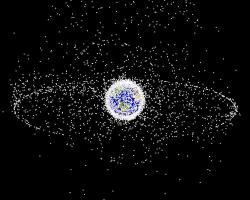
Space debris is becoming a growing problem. The number of non-operating satellites in orbit has increased, as well as debris from spacecraft explosions and, as happened earlier this year, collisions between satellites.
“The Earth has become virtually a beehive,” Chang Diaz said. “The number of satellites orbiting the Earth, we’re talking hundreds of thousands of these objects. Some of them are just junk that’s floating there simply because these satellites have run out of fuel and they just remain in orbit dead.”
The rocket, called the VASIMR for “variable specific impulse magnetoplasma rocket,” uses a high-power technology initially studied by NASA that turns argon into plasma. Propelled by an exhaust gas at temperatures close to that of the sun, the VASIMR VX-200 engine would have the ability to change orbits and accelerate and decelerate in order to pick up space debris.
In September, Chang Diaz’s company, Ad Astra, tested the rocket and achieved a milestone. During the a test on in a vacuum chamber on Earth, the engine cranked at just over 200 kilowatts, becoming the world’s most powerful electric rocket.
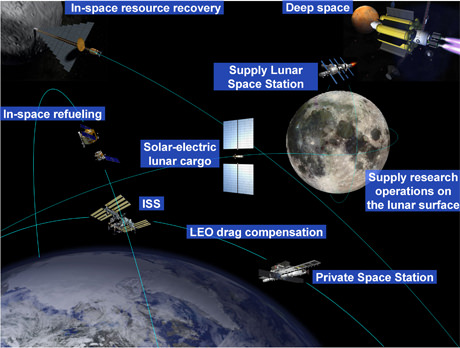
VASIMR is not suitable to launch payloads from the surface of the Earth due to its low thrust to weight ratio and its need of a vacuum to operate. It would, however be ideal to function as an upper stage for cargo, drastically reducing the fuel requirements for in-space transportation.
Ad Astra has also signed an agreement with NASA to test a 200-kilowatt VASIMR engine on the International Space Station in 2013 to help keep it in orbit. ISS boosts are currently provided by conventional thrusters, which consume about 7.5 tons of propellant per year. By cutting this amount down to 0.3 tons, Chang-Diaz estimates that VASIMR could save NASA millions of dollars per year.
Other uses of the plasma rocket engine would be lunar cargo transport, human missions to Mars or other destinations, and in-space refueling.
Sources: Global Post, Ad Astra
Black Hole Drive Could Power Future Starships
[/caption]
What would happen if humans could deliberately create a blackhole? Well, for starters we might just unlock the ultimate energy source to create the ultimate spacecraft engine — a potential “black hole-drive” — to propel ships to the stars.
It turns out black holes are not black at all; they give off “Hawking radiation” that causes them to lose energy (and therefore mass) over time. For large black holes, the amount of radiation produced is miniscule, but very small black holes rapidly turn their mass into a huge amount of energy.
This fact prompted Lois Crane and Shawn Westmoreland of Kansas State University to calculate what it would take to create a small black hole and harness the energy to propel a starship. They found that there is a “sweet spot” for black holes that are small enough to be artificially created and to produce enormous amounts of energy, but are large enough that they don’t immediately evaporate in a burst of particles. Their ideal black hole would have a mass of about a million metric tons and would be about one one-thousandth the size of a proton.
To create such a black hole, Crane and Westmoreland envision a massive spherical gamma-ray laser in space, powered by thousands of square kilometers of solar panels. After charging for a few years, this laser would release the pent-up energy equivalent to a million metric tons of mass in a converging spherical shell of photons. As the shell collapses in on itself, the energy becomes so dense that its own gravity focuses it down to a single point and a black hole is born.
The black hole would immediately begin to disgorge all the energy that was compressed to form it. To harness that energy and propel a starship, the black hole would be placed at the center of a parabolic electron-gas mirror that would reflect all the energy radiated from the black hole out the back of the ship, propelling the ship forward. Particle beams attached to the ship behind the black hole would be used to simultaneously feed the black hole and propel it along with the ship.
Such a black hole drive could easily accelerate to near the speed of light, opening up the cosmos to human travelers, but that’s just the beginning. The micro-black hole could also be used as a power generator capable of transforming any matter directly into energy. This energy could be used to create new black holes and new power generators. Obviously, creating and harnessing black holes is not an easy undertaking, but Crane and Westmoreland point out that the black hole drive has a significant advantage over more speculative technologies like warp drives and wormholes: it is physically possible. And, they believe, worth pursuing “because it allows a completely different and vastly wider destiny for the human race. We should not underestimate the ingenuity of the engineers of the future.”

